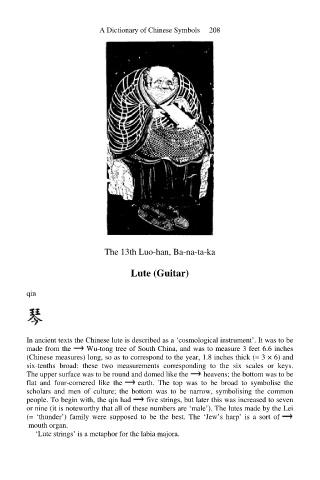Page 215 - A Dictionary of Chinese Symbols BIG Book
P. 215
A Dictionary of Chinese Symbols 208
The 13th Luo-han, Ba-na-ta-ka
Lute (Guitar)
qin
In ancient texts the Chinese lute is described as a ‘cosmological instrument’. It was to be
made from the Wu-tong tree of South China, and was to measure 3 feet 6.6 inches
(Chinese measures) long, so as to correspond to the year, 1.8 inches thick (= 3 × 6) and
six-tenths broad: these two measurements corresponding to the six scales or keys.
The upper surface was to be round and domed like the heavens; the bottom was to be
flat and four-cornered like the earth. The top was to be broad to symbolise the
scholars and men of culture; the bottom was to be narrow, symbolising the common
people. To begin with, the qin had five strings, but later this was increased to seven
or nine (it is noteworthy that all of these numbers are ‘male’). The lutes made by the Lei
(= ‘thunder’) family were supposed to be the best. The ‘Jew’s harp’ is a sort of
mouth organ.
‘Lute strings’ is a metaphor for the labia majora.

